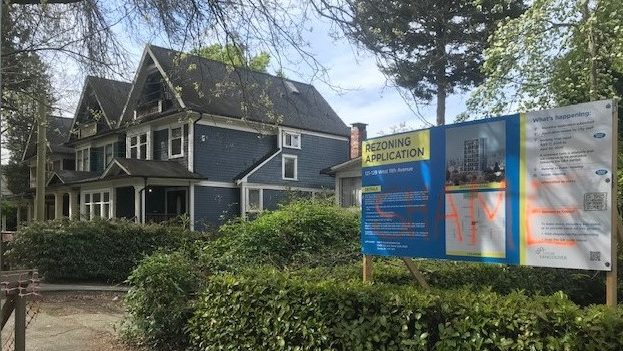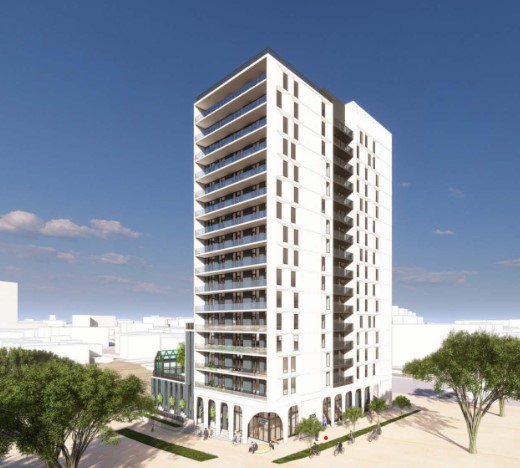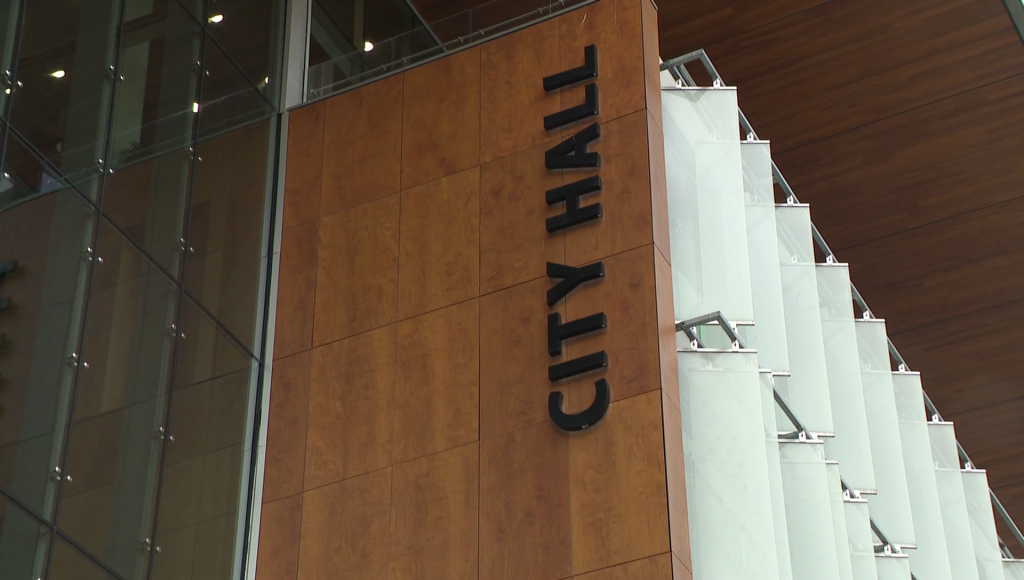13 highrises proposed for Mount Pleasant as part of Broadway Plan

Posted May 5, 2024 5:06 pm.
Last Updated May 6, 2024 7:38 am.
Nearly two years after the Broadway Plan was approved by Vancouver city councillors, development boards are cropping up all over Mount Pleasant.
Highrises are being proposed where 100-year-old homes, low-rise apartment buildings, a parking lot, a strip mall, and a former retailer now sit.
Thirteen towers are currently being proposed for the neighbourhood, some as high as 32 storeys.
One of them is striking: an 18-storey rental building, taking up three lots occupied by two houses and a duplex on West 11th Avenue at Manitoba Street. It would be flanked by quaint heritage homes, one of which was built in 1912.

Peter Silin has been a homeowner on West 11th Avenue since 1988 and has been leaving leaflets around his neighbourhood, making sure residents know about what’s proposed, and that they are welcome to join him to fight it.
He sighs when asked to characterize what he sees on the development board.
“I think it’s horrible. It’s completely out of character for the neighbourhood. It’s kind of like an insult to the neighbourhood. It makes no reference to the architectural style of the neighbourhood,” he says, while pointing out other residents have had similar reactions.
“They are pretty much horrified. They are sad, they are disappointed, they are angry. I have talked to a couple people who have mixed feelings about it. But the mixed feelings have to do with having sympathy for the idea of needing new housing.”
For the past two years, residents, and especially renters, have been bracing for the highrises that were going to be coming with the Broadway Plan.
The plan allows for the rezoning of 500 blocks on either side of Broadway, to allow for highrises, focusing on rental housing, along the new subway. The plan covers 1st Avenue to 16th Avenue, from Clark to Arbutus. Highrises that are 20 storeys must dedicate 20 per cent of their floor space to below-market rental housing.
Albert Huang is with Abundant Housing, which advocates for more housing. His day job is at Terra, a non-profit housing development agency.
He says after two years of waiting out some economic uncertainty, developers are ready to offer up their big bold ideas to city hall and the general public.
“Builders and developers believe that the worst of cost escalations have abated. Market rents have gone up to a point that higher rents can pay for new developments,” explains Huang.
The development signs, along with the opening of public comment periods, mark the beginning of a lengthy process. It could be years before construction crews are on the site — if the projects get approved by city council.
“It happens that sometimes someone puts together a development team, moves the project through one hurdle, and they run out of money, frankly. And so they find someone else to buy the project off of them,” Huang points out.
“This is pretty condemning in how we deliver housing. That whole process could take three to five years before shovels are in the ground.”
Last year, city council deliberated on a phased-in schedule for developments in the Broadway Plan. But that was defeated.
Havn, which is proposing the tower on West 11th, will have to go through extra hoops, as its project does not conform with the city’s current view cone policy.

Havn declined the opportunity to comment for this story, other than to say, “We always aim to provide engaging projects that enhance neighbourhood amenities in existing communities.”
City officials and councillors will also have to consider the shadows the towers cast on neighbouring homes. Every proposal provides a shadow study, to illustrate how shadows will travel over neighbours, over the course of a day according to time of year.
Havn’s West 11th development would share a corner with Major Matthews Park, with residents already voicing concerns about sun being blocked in the park. In a public question forum for the development, the city says the proposal’s interface with the park is being reviewed. The Broadway Plan, it notes, states that for some parks, maintaining solar access is challenging.

The shadow issue is something developers are used to grappling with. The Goodman Report, issued by commercial brokers Goodman Commercial, released a tongue-in-cheek April Fools article this year, suggesting the city was setting up tanning salons to help area residents deal with their sunlight deficit.
Besides the rezoning phase, the public hearing phase, the permit phase, and the demolition phase, developers who are bulldozing apartments and multi-suite homes to make room for their towers will also be tasked with rehousing displaced tenants, if the tenants exercise their rights of first refusal to occupy the new units. A tenant and relocation policy is part of the Broadway Plan.
That is the scenario that will play out at 25 East 12th Avenue, 215 East 13th Avenue, and 270 East 13th Avenue, where towers would replace low-rise apartment buildings. The floor plans in all of the proposals show one-bedroom suites occupying spaces in the 400 to 500 square foot range. Three bedrooms will be squeezed into spaces as small as 800 square feet.
The impact on local infrastructure such as schools is something city councillors might consider. Simon Fraser Elementary, which is the catchment school for six of the proposed towers, already conducts lotteries for kindergarten enrolment.

Some developers and city planners are now going public with their criticisms of the Broadway Plan. In a recent op-ed, retired architect Scot Hein and retired urban planner Arny Wise say, “The entire rationale for the Broadway Plan — that higher densities will deliver housing affordability — was flawed,” and that the 20 per cent-below-market provision doesn’t adequately address today’s acute housing crisis.
And Michael Geller, the principal of the Geller Group, also recently aired his serious reservations about the plan in an op-ed. He cites what he calls “the unfavourable impacts of high density, highrise buildings on established low-density neighbourhoods four to six blocks away from Broadway.”
Huang maintains neighbourhoods are not static, and that residents shouldn’t resist change, because he says people, not buildings, define where we live.
“We found where projects that were initially opposed and the projects were eventually built, after families and individuals moved into them, they were embraced by the community,” he says.
People like Silin, though, think there is merit in preserving the flavour of the neighbourhood. “I think easily they could develop something that is appropriate, that is three or four storeys, that is a townhouse or an architectural reference to the styles of homes around them.”
The 13 proposed towers
One 14-storey tower at 121 West 11th Ave.
Two 28-storey towers at 130 West Broadway
A 21-storey tower at 24 East Broadway
Two 21-storey towers at 25 East 12th Ave.
A 21-storey tower at 215 East 13th Ave.
A 20-storey tower at 270 East 13th Ave.
Two 32/25 storey towers at 2950 Prince Edward St.
A 19-storey tower at 523 East 10th Ave.
An 18-storey tower at 2535 Carolina St.
A 24-storey tower at 701 Kingsway











